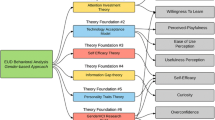Abstract
The absence of women in IT has tangible social and technical consequences. Whoever designs the interfaces, defines the functionalities, and writes the algorithms behind them also infuses them with their rational, way of thinking, and modus operandi. If women are typically only users, and not developers, of IT, the female perspective, or more broadly diversity, will be missing from the process of design, creation, and development. This consideration is even more crucial in Human Computer Interaction when looking at the design of usable, useful, and used systems. But how can we measure the impact of neglecting diversity, including diversity of gender, in User Experience (UX)? In this poster, we propose to elaborate on which UX dimensions and factors are contributing to usability to better convey the importance of diversity, as well as addressing whether there is a need to introduce new criteria and measures to account for gender related differences. We expect to deliver an enriched evaluation framework for assessing the performance of technology and the kind of experience it offers to different users while keeping the discussion open in the HCI community and beyond.
This project was partially supported by COST Action CA19122 – European Network for Gender Balance in Informatics (EUGAIN).
Access this chapter
Tax calculation will be finalised at checkout
Purchases are for personal use only
Similar content being viewed by others
Notes
- 1.
The authors used UEQ and VISAWI-S questionnaires, neither of which is geared specifically towards capturing gender issues.
References
Borrett, A.: Why big tech stocks boomed in the pandemic. Tech Monitor (2020). https://techmonitor.ai/techonology/cloud/why-big-tech-stocks-boomed-covid-19
Poletti, T., Owens, J.C.: Opinion: Big tech’s trillion-dollar pandemic year may be just the beginning. Market Watch (2021). https://www.marketwatch.com/story/big-techs-trillion-dollar-pandemic-year-may-be-just-the-beginning-11619813888
European Commission: A comparison of shortage and surplus occupations based on analyses of data from the European Public Employment Services and Labour Force Surveys - Labour shortages and surpluses (2017)
International Labour Organization: Skills shortages and labour migration in the field of information and communication technology in India, Indonesia and Thailand. www.ilo.org. Accessed 08 Mar 2022
Eurostat: ICT specialists in employment. https://ec.europa.eu/eurostat/statistics-explained/index.php?title=ICT_specialists_in_employment. Accessed 08 Mar 2022
Joó, M.: Sztereotípiák, bináris oppozíciók, előítéletek – és a Nő. In: Barát, E., Sándor, K. (eds.) A nő és női(es)ség sztereotípiái. “Nyelv, ideológia, Média 2”, pp. 9–22. SZTE Könyvtártudományi Tanszék, Szeged (2009)
Meissner, H.: A nem társadalmi konstrukciója. Megismerési nézőpontok és társadalomelméleti kérdések. In: Juhász, V., Kegyesné Szekeres, E. (eds.) Társadalmi nyelv és nyelvhasználat. Válogatott szemelvények az angol és a német szakirodalomból, pp. 45–73. Szegedi Egyetemi Kiadó, Szeged (2011)
Butler, J.: Gender Trouble. Routledge, Milton Park (2007)
Crenshaw, K.: Demarginalizing the intersection of race and sex: a black feminist critique of antidiscrimination doctrine, feminist theory and antiracist politics. Univ. Chicago Legal Forum 1989, Article 8 (1989)
West, C., Zimmerman, D.H.: Doing gender. Gend. Soc. 1(2), 125–151 (1987)
American Dialect Society: 2019 Word of the Year is “(My) Pronouns,” Word of the Decade is Singular “They”. https://www.americandialect.org/2019-word-of-the-year-is-my-pronouns-word-of-the-decade-is-singular-they. Accessed 09 Mar 2022
de Beauvoir, S.: The second sex. Alfred A. Knopf. (1971)
Kovács, M. (ed.): Társadalmi nemek. Elméleti megközelítések és kutatási eredmények (Gender: Theoretical approaches and research results). Eötvös kiadó (2017)
Sperling, G.B., Winthrop, R.: What Works in Girls’ Education: Evidence for the World's Best Investment. Brooking Institution (2016)
Frehill, L.M., Cohoon, J.M.: Gender and computing. In: Pearson, W., Frehill, L.M., McNeely, C.L. (eds.) Advancing women in science, pp. 237–272. Springer, Cham (2015). https://doi.org/10.1007/978-3-319-08629-3_8
Mansour, N., Wegerif, R.: Science Education for Diversity: Theory and Practice. Springer, Devon (2013). https://doi.org/10.1007/978-94-007-4563-6
UNICEF: Girls’education. https://www.unicef.org/education/girls-education. Accessed 09 Mar 2022
Kirkup, G.: ICT as a tool for enhancing women’s education opportunities, and new educational and professional opportunities for women in new technologies. United Nations Division for the Advancement of Women (UNDAW) (2002)
OECD: Women in politics. https://data.oecd.org/inequality/women-in-politics.htm. Accessed 08 Mar 2022
European Union Agency for Fundamental Rights (FRA): Violence against women: An EU-wide survey. https://fra.europa.eu/en/publication/2014/violence-against-women-eu-wide-survey-main-results-report. Accessed 08 Mar 2022
Szlávi, A.: The Construction of Gender in Hungarian Discourses. Doctoral dissertation. Eötvös Loránd University (2019)
Chiam, Z., Duffy, S., Gonzáles Gil, M., Goodwin, L., Mpemba Patel, N.T.: Trans legal mapping report – Recognition before the law 2019. ILGA World. https://ilga.org/trans-legal-mapping-report. Accessed 09 Mar 2022
Crutzen, C.: Questioning gender in e-learning and its relation to computer science. Space for design, working, and learning. In: Braidotti, R., van Baren, A. (eds.) The Making of European Women’s Studies, vol. VI. University of Utrecht, pp. 40–59 (2005)
Moustakiss, V.S., Hermann, J.: Where do machine learning and human-computer interaction meet. Appl. Artif. Intell. 11(7), 595–609 (1997)
Buolamwini, J., Gebru, T.: Gender shades: Intersectional accuracy disparities in commercial gender classification. In: Proceedings of Machine Learning Research, vol. 81, pp. 1–15 (2018)
Aufderhaar, K., Schrepp, M., Thomaschewski, J.: Do women and men perceive user experience differently? Int. J. Interact. Multimedia Artif. Intell. 63–67 (2019)
Knoll, B., Inhof, C., Posch, P.: Gender Screening – Männer an Maschinen und Frauen im Labormantel [Report (short version): Gender Screening - Men on Machines and Women in Laboratory Coats]. Studie zur Repräsentation von Frauen und Männern in ausgewählten Online- und Printmedien von technischingenieurwissenschaftlichen Universitäten, Fachhochschulen und Forschungseinrichtungen in Österreich (2013)
Marsden, N.: Doing UX: Doing gender. User Experience Magazine. https://uxpamagazine.org/doing-ux/. Accessed 09 Mar 2022
Robert, K.: Women on top: inappropriate dropdowns. UX Booth. https://www.uxbooth.com/articles/women-on-top-inappropriate-dropdowns/. Accessed 09 Mar 2022
Author information
Authors and Affiliations
Corresponding author
Editor information
Editors and Affiliations
Rights and permissions
Copyright information
© 2022 The Author(s), under exclusive license to Springer Nature Switzerland AG
About this paper
Cite this paper
Szlávi, A., Landoni, M. (2022). Human Computer Interaction - Gender in User Experience. In: Stephanidis, C., Antona, M., Ntoa, S. (eds) HCI International 2022 Posters. HCII 2022. Communications in Computer and Information Science, vol 1580. Springer, Cham. https://doi.org/10.1007/978-3-031-06417-3_18
Download citation
DOI: https://doi.org/10.1007/978-3-031-06417-3_18
Published:
Publisher Name: Springer, Cham
Print ISBN: 978-3-031-06416-6
Online ISBN: 978-3-031-06417-3
eBook Packages: Computer ScienceComputer Science (R0)




